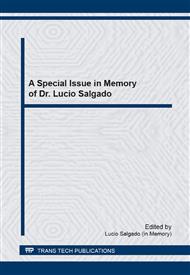p.492
p.498
p.504
p.508
p.513
p.519
p.525
p.530
p.536
Synthesis of LaNi0,6Fe0,4O3-δ (LNF64) by Pechini Method for Use as Cathode in SOFC´S
Abstract:
The solid oxide fuel cell are an alternative of production clean and efficient energy, because converts chemical energy in electrical energy. A fuel cell is formed basically by an electrolyte, a cathode and an anode. The main electrolyte used for SOFC manufacturing is the ZrO2-Y2O3. The materials for electrode manufacturing must possess thermal expansion characteristics close to electrolyte and have high electrical conductivity in operating temperature. Recently, the perovskite LaNi0,6Fe0,4O3-δ, has attracted interest for application as cathode in SOFC ́s for has a high electronic conductivity and a thermal expansion coefficient whish for the zirconia electrolyte. This work aimed to LaNi0,6Fe0,4O3-δ obtained by Pechini method. The powders were characterized by differential thermal analysis, thermogravimetric analysis, x-ray diffraction, energy dispersion X-ray fluorescence spectroscopy, helium pycnometry and scanning electron microscopy. The results showed powders obtained with perovskite formation when calcined 600°C during 2 hours.
Info:
Periodical:
Pages:
513-518
Citation:
Online since:
September 2014
Keywords:
Price:
Сopyright:
© 2015 Trans Tech Publications Ltd. All Rights Reserved
Share:
Citation:


